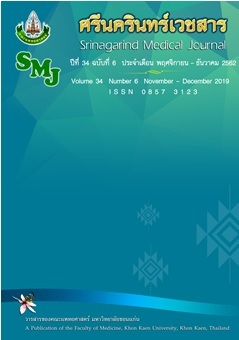Tangeretin Alleviates L-NAME Induced Vascular Dysfunction in Rats
Keywords:
Tangeretin, Vascular dysfunction, L-NAME-treated rats, แทนเจอรีติน, การทำงานของหลอดเลือดที่ผิดปกติ, หนูที่ได้รับสารแอลเนมAbstract
แทนเจอรีตินบรรเทาแอลเนมชักนำการทำงานผิดปกติของหลอดเลือดในหนูแรท
จุฑามาศ วันเพ็ชร 1,4, พัชรวิภา มณีไสย 1,4, สราวุธ บรรบุผา 3, เทวฤทธิ์ เบิกบาน 3, ปาริฉัตร ประจะเนย์ 2,4, ยุพา คู่คงวิริยพันธุ์ 1,4, พวงรัตน์ ภักดีโชติ 1,4,*
1 ภาควิชาสรีรวิทยา คณะแพทยศาสตร์ มหาวิทยาลัยขอนแก่น ขอนแก่น ประเทศไทย
2 ภาควิชากายวิภาคศาสตร์ คณะแพทยศาสตร์ มหาวิทยาลัยขอนแก่น ขอนแก่น ประเทศไทย
3 คณะแพทยศาสตร์ มหาวิทยาลัยมหาสารคาม มหาสารคาม ประเทศไทย
4 กลุ่มวิจัยหัวใจและหลอดเลือดและคณะแพทยศาสตร์ มหาวิทยาลัยขอนแก่น ขอนแก่น ประเทศไทย
หลักการและวัตถุประสงค์: แทนเจอรีติน (Tangeretin) เป็นสารประกอบฟลาโวนอยด์ที่พบในผลไม้ตระกูลส้ม มีหลายการศึกษาเกี่ยวกับแทนเจอรีตินพบว่าแทนเจอรีตินมีฤทธิ์ต่อต้านการเสื่อมของระบบประสาท ต้านการอักเสบ และต้านอนุมูลอิสระ วัตถุประสงค์ของการศึกษานี้เพื่อตรวจสอบผลของแทนเจอรีตินต่อการทำงานของหลอดเลือดในหนูแรทที่ได้รับสารแอลเนม (L-NAME)
วิธีการศึกษา: หนูแรทถูกแบ่งออกเป็น 4 กลุ่ม กลุ่มที่ 1 คือหนูแรทที่ได้รับสารแอลเนม (40 มก./กก.) ในน้ำกลั่น กลุ่มที่ 2 และ 3 คือหนูแรทที่ได้รับสารแอลเนมร่วมกับสารแทนเจอรีติน (15 และ 30 มก./กก. ตามลำดับ) กลุ่มที่ 4 คือหนูแรทกลุ่มปกติได้รับเพียงน้ำกลั่น (n=7 ต่อกลุ่ม) เมื่อสิ้นสุดการทดลองทำการประเมินการตอบสนองของหลอดเลือดต่อการกระตุ้นโดยกระแสไฟฟ้าและสารที่มีผลต่อหลอดเลือดในหลอดเลือดมีเซนเทอริกและเอออตาร์
ผลการศึกษา: การเพิ่มขึ้นอย่างมีนัยสำคัญทางสถิติของการหดตัวตอบสนองต่อการกระตุ้นโดยกระแสไฟฟ้าถูกพบในหลอดเลือดมีเซนเทอริกของหนูแรทที่ได้รับสารแอลเนม (p<0.05) แทนเจอรีตินสามารถลดการหดตัวตอบสนองต่อการกระตุ้นโดยกระแสไฟฟ้าได้ในหนูแรทที่ได้รับสารแอลเนมร่วมกับแทนเจอรีตินเมื่อเทียบกับหนูที่ได้รับแค่สารแอลเนม(p<0.05) แต่อย่างไรก็ตามการหดตัวตอบสนองต่อนอร์เอพิเนฟริน (Norepinephrine) ไม่มีความแตกต่างกันระหว่างกลุ่ม การตอบสนองคลายตัวของหลอดเลือดต่อสารอะซิติลโคลีนในหลอดเลือดมีเซนเทอริกและเอออตาร์ลดลงอย่างมีนัยสำคัญทางสถิติในหนูแรทที่ได้รับสารแอลเนมเมื่อเทียบกับหนูปกติ (p<0.05) แทนเจอรีตินสามารถปรับปรุงการตอบสนองคลายตัวของหลอดเลือดต่อสารอะซิติลโคลีน (Acetylcholine) ให้ดีขึ้นในหนูแรทที่ได้รับสารแอลเนมร่วมกับแทนเจอรีตินเมื่อเทียบกับหนูที่ได้รับแค่สารแอลเนม (p<0.05) ซึ่งการตอบสนองคลายตัวของหลอดเลือดต่อสารโซเดียมไนโตรปรัสไซด์ (Sodium nitroprusside) ไม่มีความแตกต่างอย่างมีนัยสำคัญระหว่างกลุ่ม
สรุป: ผลการทดลองของการศึกษานี้บ่งชี้ว่าแทนเจอรีตินสามารถยับยั้งการตอบสนองต่อการหดตัวของระบบประสาทซิมพาเธติกและปรับปรุงการคลายตัวของหลอดเลือดจากเอนโดทีเลียมให้ดีขึ้นในหนูแรทที่ได้รับสารแอลเนม
Background and Objective: Tangeretin is a flavonoid compound found in citrus fruits. Several biological activities of tangeretin have been revealed including; anti-neurodegeneration, anti-inflammation, and anti-oxidation. This study was to investigate the effects of tangeretin on vascular function in L-NAME-treated rats.
Methods: Rats were divided into 4 groups. Groups I; rats treated with L-NAME (40 mg/kg) in drinking water only, Groups II and III; rats treated with L-NAME together with tangeretin (15 and 30 mg/kg, respectively), Groups IV; control rats were received only distilled water (n=7/each group). At the end of experiment, vascular responses to electrical field stimulation (EFS) and vasoactive agents in mesenteric vascular beds and aortic rings were evaluated.
Results: A significant increase in contractile response to electrical EFS was observed in the mesenteric vascular bed isolated from L-NAME-treated rats (p<0.05). Tangeretin reduced the augmented response to EFS in L-NAME-treated rats comparing to those of untreated rats (p<0.05). However, the contractile response to exogenous norepinephrine was not different among groups. Vasorelaxation responses to acetylcholine (ACh) in the mesenteric vascular beds and aortic rings were significantly blunted in L-NAME-treated rats compared to control rats (p<0.05). Treatment with tangeretin improved the vasorelaxation response to ACh in L-NAME-treated rats compared to untreated rats (p<0.05). There was no significant difference in the
vasorelaxation responses to sodium nitroprusside among groups.
Conclusions: The results of this study indicated that tangeretin suppresses sympathetic nerve mediated contractile response and improves endothelium-dependent vasorelaxtion in L-NAME-treated rats.
References
Bruno RM, Ghiadoni L, Seravalle G, Dell'Oro R, Taddei S, Grassi G. Sympathetic regulation of vascular function in health and disease. Front Physiol 2012; 3: 284
Wyss JM. The role of the sympathetic nervous system in hypertension. Curr Opin Nephrol Hy 1993; 2: 265-73
Bergamaschi CsT, Campos RR, Lopes OU. Rostral ventrolateral medulla: A source of sympathetic activation in rats subjected to long-term treatment with l-name. Hypertension 1999; 34: 744-7
Augustyniak RA, Victor RG, Morgan DA, Zhang W. L-name-and adma-induced sympathetic neural activation in conscious rats. Am J Physiol Regul Integr Comp 2006; 290: R726-32
Colonna VDG, Rossoni G, Rigamonti AE, Bonomo S, Manfredi B, Berti F, et al. Enalapril and quinapril improve endothelial vasodilator function and aortic enos gene expression in l-name-treated rats. Eur J Pharmacol 2002; 450: 61-6
Paulis L, Zicha J, Kunes J, Hojna S, Behuliak M, Celec P, et al. Regression of l-name–induced hypertension: The role of nitric oxide and endothelium-derived constricting factor. Hypertens Res 2008; 31: 793
Fu J-Y, Qian L-B, Zhu L-G, Liang H-T, Tan Y-N, Lu H-T, et al. Betulinic acid ameliorates endothelium-dependent relaxation in l-name-induced hypertensive rats by reducing oxidative stress. Eur J Pharm Sci 2011; 44: 385-91
Bitar MS, Wahid S, Mustafa S, Al-Saleh E, Dhaunsi GS, Al-Mulla F. Nitric oxide dynamics and endothelial dysfunction in type ii model of genetic diabetes. Eur J Pharmacol 2005; 511: 53-64
Lee YY, Lee E-J, Park J-S, Jang S-E, Kim D-H, Kim H-S. Anti-inflammatory and antioxidant mechanism of tangeretin in activated microglia. J Neuroimmune Pharmacol 2016; 11: 294-305
Yang J-s, Wu X-h, Yu H-g, Teng L-s. Tangeretin inhibits neurodegeneration and attenuates inflammatory responses and behavioural deficits in 1-methyl-4-phenyl-1, 2, 3, 6-tetrahydropyridine (mptp)-induced parkinson’s disease dementia in rats. Inflammopharmacology 2017; 25: 471-84
Lu H, Tan Y, Yang L, Dong H, Liao Y, Cao S, et al. Cardioprotective efficiency of tangeretin against heart failure induced by isoproterenol in rats. Int J Pharmacol 2018; 14: 1145-52
Omar HA, Mohamed WR, Arab HH, Arafa E-SA. Tangeretin alleviates cisplatin-induced acute hepatic injury in rats: Targeting mapks and apoptosis. PloS One 2016; 11: e0151649
Wu J, Zhao Y-M, Deng Z-K. Tangeretin ameliorates renal failure via regulating oxidative stress, nf-κb–tnf-α/inos signalling and improves memory and cognitive deficits in 5/6 nephrectomized rats. Inflammopharmacology 2018; 26: 119-32
Kawasaki H, Takasaki K, Saito A, Goto K. Calcitonin gene-related peptide acts as a novel vasodilator neurotransmitter in mesenteric resistance vessels of the rat. Nature 1988; 335: 164-7.
Tousoulis D, Kampoli AM, Tentolouris Nikolaos Papageorgiou C, Stefanadis C. The role of nitric oxide on endothelial function. Curr Vasc Pharmacol 2012; 10: 4-18.
Förstermann U. Nitric oxide and oxidative stress in vascular disease. Pflug Arch Eur J Phy 2010; 459: 923-39


